 As a native New Yorker, I’ve ridden the subways all my life. In terms of their safety or lack thereof, they haven’t changed much over those decades. Consequently, now and again, checking to see if a train was coming, I’ve stood at the edge of the platform, looking down at the railbed almost four feet below me. Inevitably, I’ve wondered how I’d get back up if I fell, jumped, or got pushed onto the tracks, and what I’d do once down there if I saw a train heading my way.
As a native New Yorker, I’ve ridden the subways all my life. In terms of their safety or lack thereof, they haven’t changed much over those decades. Consequently, now and again, checking to see if a train was coming, I’ve stood at the edge of the platform, looking down at the railbed almost four feet below me. Inevitably, I’ve wondered how I’d get back up if I fell, jumped, or got pushed onto the tracks, and what I’d do once down there if I saw a train heading my way.
There’s a recess beneath the platform, which means no foothold or surface against which to brace oneself for the climb. Unless one had unusual upper-body strength, hauling oneself onto the platform from the tracks would prove difficult. For the same reason, it would take considerable strength and extraordinary effort to stand or lie on the platform while pulling up to safety someone of adult size; once that person’s feet left the railbed, they’d become dead weight.
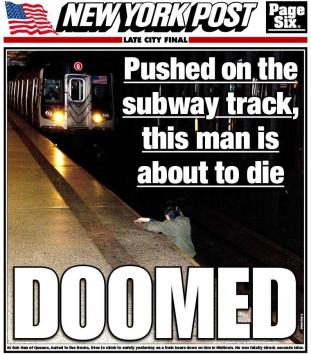
New York Post cover, subway death, 12-4-12. Photograph by R. Umar Abbasi.
Over the years I’ve seen many repair and maintenance crews at work on the tracks, but I’ve never seen one of their number — sturdy guys, invariably, as those jobs require — either jump down onto the tracks from the platform or pull himself up from the tracks, with or without help. They use ladders built into the walls at the ends of each platform for access.
Ki-Suck Han’s best chances for survival after Naeem Davis allegedly shoved him from the platform to the railbed of the 49th St. station of the Q train in Manhattan on December 3 lay in (a) crouching in the recess under the platform, (b) flattening himself between the tracks on the railbed, or (c) running away from the approaching train toward the end of the platform, giving the motorman more time to brake. Relying on anyone to reach him in time to get him out of harm’s way would have been some version of a Hail Mary pass.
As I see it, photographer R. Umar Abbasi, present but some distance away, had a few seconds in which to decide whether he himself was in danger from the alleged perp coming his way, how and where he could shed his camera and backpack full of equipment, whether he could reach Han in time, and whether he could haul him up without risking his own life. I wouldn’t have tried it myself; I don’t have the strength to pull a grown man up from that height.
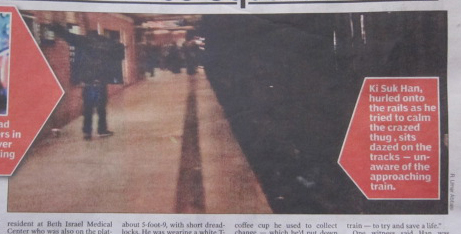
Abbasi’s Photograph #1: Davis, who allegedly pushed Han, at left. Han is sitting on the tracks, lower right. (Credit: photo of spread from NY Post print version. Subway photo by R. Umar Abbasi.)
Assuming that Abbasi quickly came to the same conclusion, then as a professional photographer he was simply and accidentally on the scene at a definitely newsworthy public event: the death of a citizen thrown to the subway tracks by another citizen. He made photos thereof, the only visual evidence of the event as it occurred. He disclosed them to the police, for their forensic value, and simultaneously to his editors, and licensed usage rights to them for publication.
All of that is both standard practice and entirely legal. That’s what photojournalists and press photographers (and documentary photographers) do. I don’t have a problem with that in general, nor in this specific case. As always, I stand ready to be judged for the positions I take. So, I assume, do those photographers, and the editors and publishers who bring their work before the public.
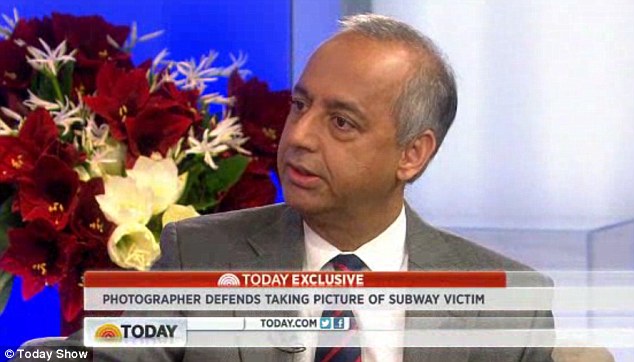
R. Umar Abbasi, Today Show, 12-5-12, screenshot.
Abbasi has claimed that he had his camera set for outdoor lighting, and that the images came about as a by-product of his decision to shoot off his flash in the direction of Han and the approaching train, in an attempt to alert the motorman. Short of putting him under hypnosis for a lie-detector test, and subjecting his RAW files to examination by specialists, we’ll never know much more, but I’m inclined to take him at his word.
I’ve read his account and watched his several televised interviews, and he doesn’t come across as some hardened, “self-centered” paparazzo “looking for his Warholesque moment,” as one reader suggested in an email. This isn’t a pack journalist hounding Princess Di, or an obsessed Ron Galella stalking Jackie O. From his online portfolio, Abbasi is a middle-aged, run-of-the-mill photographer who appears to do a bit of everything: studio portraits, child photography, nudes, nature studies, “soft” photojournalism (parades, sailboat races), none of it with any distinction.
The Blame Game
![]() Kenneth Irby of The Poynter Institute for Media Studies puts the onus on the editors of the New York Post who decided to run the image on the front page of their edition. “The moment just before death is a delicate fraction of a second and the NY Post print edition and cover screen image lacks compassion for the victim, his family, his friends and the Post’s audience. In a few words it is disgusting, disconcerting, insensate and intrusive,” Irby wrote, adding “This moment was too private in my view.” (Exactly how recording or publishing an image of a visible life-or-death crisis in an extremely public place can qualify as “intrusive” into something “too private” goes unexplained.)
Kenneth Irby of The Poynter Institute for Media Studies puts the onus on the editors of the New York Post who decided to run the image on the front page of their edition. “The moment just before death is a delicate fraction of a second and the NY Post print edition and cover screen image lacks compassion for the victim, his family, his friends and the Post’s audience. In a few words it is disgusting, disconcerting, insensate and intrusive,” Irby wrote, adding “This moment was too private in my view.” (Exactly how recording or publishing an image of a visible life-or-death crisis in an extremely public place can qualify as “intrusive” into something “too private” goes unexplained.)
 But while some blame the Post editors for running the image (or at least putting it on the front cover), Abbasi has found himself the target of a remarkable degree of condemnation and even vituperation. For a sample of both, try “The New York Post defends its indefensible photo,” published at Salon.com on December 5, in which Mary Elizabeth Williams pretty much reads Abbasi out of the human race. Yet, interestingly, not for his failure to rescue Han. She writes, “Not sure how pointing a flashing camera at a speeding train signals the conductor in a more efficient way than yelling or waving your arms.” (Really?) But she also states, “It’s not that a photographer has any more obligation to intervene in a dramatic situation than anyone else. Abbasi’s first duty, like anyone’s, is to himself and his own safety.” (Here Williams and I see eye to eye; she clearly and fundamentally disagrees with John Long, Ethics Committee Chair of the National Press Photographers Association, whose position on these matters I challenged in my previous post.)
But while some blame the Post editors for running the image (or at least putting it on the front cover), Abbasi has found himself the target of a remarkable degree of condemnation and even vituperation. For a sample of both, try “The New York Post defends its indefensible photo,” published at Salon.com on December 5, in which Mary Elizabeth Williams pretty much reads Abbasi out of the human race. Yet, interestingly, not for his failure to rescue Han. She writes, “Not sure how pointing a flashing camera at a speeding train signals the conductor in a more efficient way than yelling or waving your arms.” (Really?) But she also states, “It’s not that a photographer has any more obligation to intervene in a dramatic situation than anyone else. Abbasi’s first duty, like anyone’s, is to himself and his own safety.” (Here Williams and I see eye to eye; she clearly and fundamentally disagrees with John Long, Ethics Committee Chair of the National Press Photographers Association, whose position on these matters I challenged in my previous post.)
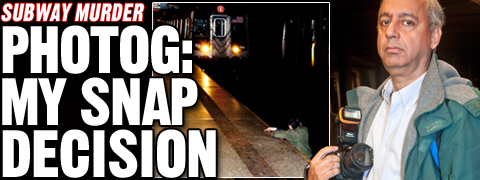
No, Williams reprimands Abbasi for having the temerity to publish an article explaining how and why the images got made, an explanation made necessary by precisely the sort of attack that Williams levels at him. “What’s repulsive is that he then chose to not just sell that photograph, but then brashly write a story in which he’s the guy using his camera to try to stop a train, in which he’s telling other people taking pictures to use restraint, and getting thanked for it. How can Abbasi even walk around, with cojones that big?”
So, for making the only visual documentation of this deeply disturbing public event, providing it immediately to the police, licensing use of the image to the Post, then reluctantly drafting a written account of the situation for the Post (the only eyewitness to have done so for publication), he becomes a braggart in Williams’s opinion. According to her, Abbasi’s self-servingness is intensified by the fact that his image doesn’t resonate for her to the degree that Robert Capa’s photo of a falling Loyalist soldier in the Spanish Civil War does (an image that raises its own set of ethical concerns).
As for the photograph being “gruesome” and “grisly,” as Williams claims: There is nothing inherently disturbing about the image in and of itself; you can’t even tell from it that the train is in motion. As I noted in my first post about it, I can envision the same image with a different headline had the outcome gone otherwise: “SAVED: Pushed on the subway track, this man miraculously survived.” In which case no one would object to its publication, or castigate the photographer for not rushing to his assistance.
 Then there’s the absurd Facebook page, “Boycott Photographer R. Umar Abbasi,” with its credo: “Umar Abbasi, photographer, tried to profiteer and further his career at the expense of a human life, which he could’ve saved! We want him to send the money he made selling these photos, to the family of the victim!” Your usual assortment of semi-literate social-media haters, snarling and tearing at each other savagely when they’re not trashing Abbasi, overflowing with ‘tude but incapable of reasoned argument.
Then there’s the absurd Facebook page, “Boycott Photographer R. Umar Abbasi,” with its credo: “Umar Abbasi, photographer, tried to profiteer and further his career at the expense of a human life, which he could’ve saved! We want him to send the money he made selling these photos, to the family of the victim!” Your usual assortment of semi-literate social-media haters, snarling and tearing at each other savagely when they’re not trashing Abbasi, overflowing with ‘tude but incapable of reasoned argument.
And clueless as to how to achieve their stated purpose. Yes, we’ll boycott this freelance photographer by . . . Not hiring him! (Oh, wait, we don’t hire freelance photogs anyhow.) Well, by . . . not looking at any NY newspaper photos until we’ve read the credit lines! (Too hard!) Insulting him here and flaming him at his own FB page! Yeah, that’s a boycott! (Only 130 “likes” for this nonsense as of this writing.)
 Meanwhile, if and when you tire of these nincompoops I recommend perusing “To Post Photog R. Umar Abbasi: An Apology” by James King, published on December 6 by the Village Voice. In retracting judgmental comments he’d made in an earlier article, King writes, “The truth is, we don’t know if there was anything Abbasi could have done that he didn’t do — it’s easy to play Monday morning quarterback from the comfort of an office in the East Village. … Our apologies to Abbasi for our uninformed suggestions.” I hope a few more such acts of contrition come Abbasi’s way.
Meanwhile, if and when you tire of these nincompoops I recommend perusing “To Post Photog R. Umar Abbasi: An Apology” by James King, published on December 6 by the Village Voice. In retracting judgmental comments he’d made in an earlier article, King writes, “The truth is, we don’t know if there was anything Abbasi could have done that he didn’t do — it’s easy to play Monday morning quarterback from the comfort of an office in the East Village. … Our apologies to Abbasi for our uninformed suggestions.” I hope a few more such acts of contrition come Abbasi’s way.
[Note, March 17, 2015: Don’t know why I didn’t come across it at the time, but I’ve just found photojournalist J. Ross Baughman’s sage take on this situation and larger ethical issues embodied in the photojournalist’s role: “Should photographers help or shoot?” published at CNN on December 7, 2012. An oasis of sanity — highly recommended.]
Ethics and the NPPA
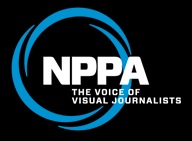 So far as I can tell, Abbasi’s not a member of the National Press Photographers Association. But were I a member of the NPPA I’d suddenly have some serious questions about the organization’s relation to my work, and to the work of press photographers in general. Such as:
So far as I can tell, Abbasi’s not a member of the National Press Photographers Association. But were I a member of the NPPA I’d suddenly have some serious questions about the organization’s relation to my work, and to the work of press photographers in general. Such as:
- Did the organization actually poll its membership on the subject of “putting the camera down” in situations where a photographer can help people under duress in other ways, and did a majority of those polled really agree with John Long’s position that “If you have placed yourself in a situation where you can help, I feel you are morally obligated to help”? If so, by how large a margin, and when did this polling take place?
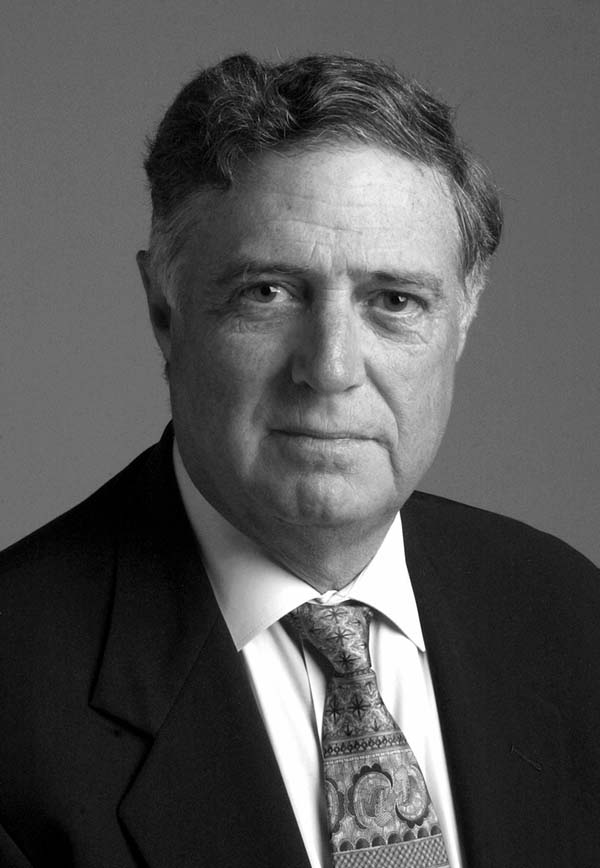
John Long, NPPA Ethics Committee chairman, official portrait.
- If the NPPA never conducted such a poll, is it ethical for Long (the organization’s Ethics Committee Chair for the past 15 years) to claim that, as journalist Jeff Bercovici of Forbes reports, “his view predominates within the organization,” thus imposing his attitude on the membership and using them, and the organization’s name, to further his personal moral agenda?
- The NPPA’s Code of Ethics includes the following assertion: “Visual journalists and those who manage visual news productions are accountable for upholding the following standards in their daily work: … While photographing subjects do not intentionally contribute to, alter, or seek to alter or influence events.” If the above poll was indeed conducted, and Long’s claim is indeed true, is it ethical for the organization to publish that as the creed to which its membership subscribes when in fact the majority of its members reject that position and don’t adhere to that practice?
- If the majority of the NPPA’s members do in fact reject that position and instead assert the primacy of “putting down the camera” when on assignment in order to render altruistic aid to people under duress, does the organization as a whole and its members individually not have an ethical obligation to disclose that publicly and so inform editors, publishers, and other prospective clients of this overriding commitment to a “higher duty,” even if it costs them work opportunities?
- Is it ethical for the Ethics Committee Chair of the NPPA not to support a photographer who, even though not a member, abides by the NPPA’s code of ethics? To put it another way, if as an NPPA member I found myself in Abbasi’s shoes someday, and scrupulously followed the NPPA’s current code of ethics to the letter by “not seeking to alter or influence events,” could I reasonably expect my professional organization to have my back, or should I instead anticipate that its Ethics Committee Chair would stab me in it?
I’m just asking.
•
(Postscript, November 19, 2014: I’ve recently learned that the National Press Photographers Association actually created something they call their “Humanitarian Award.” This is intended to “recognize individuals for playing a key role in saving the lives of others or participating in rescue situations. It was first awarded in 1985, and it is presented when deemed appropriate by NPPA’s president,” according to the organization’s website. In short, they celebrate the actions of members who violate the organization’s code of ethics. You’ll find a list of those professionals who have distinguished themselves in that fashion here. Editors beware.)
•
(For an index of links to all posts in this series, click here.)
•
This post supported by a donation from Yoshio Kishi.






This article beautifully explores the profound role of photographers as citizens, capturing not just images but the essence of society and its issues. It’s inspiring to see how photography can serve as a powerful medium for social commentary and change. The insights shared here remind us of the responsibility and impact photographers hold in shaping our perspectives and understanding of the world around us. Thank you for shedding light on this important aspect of photography!